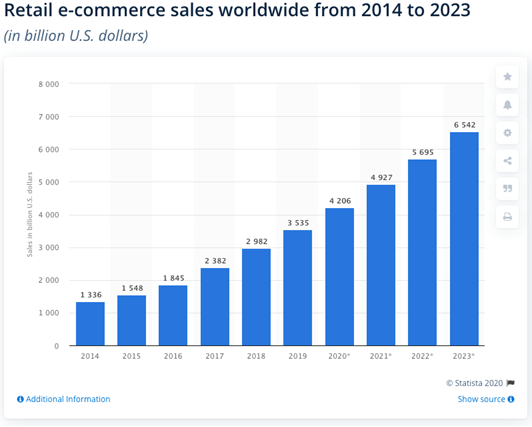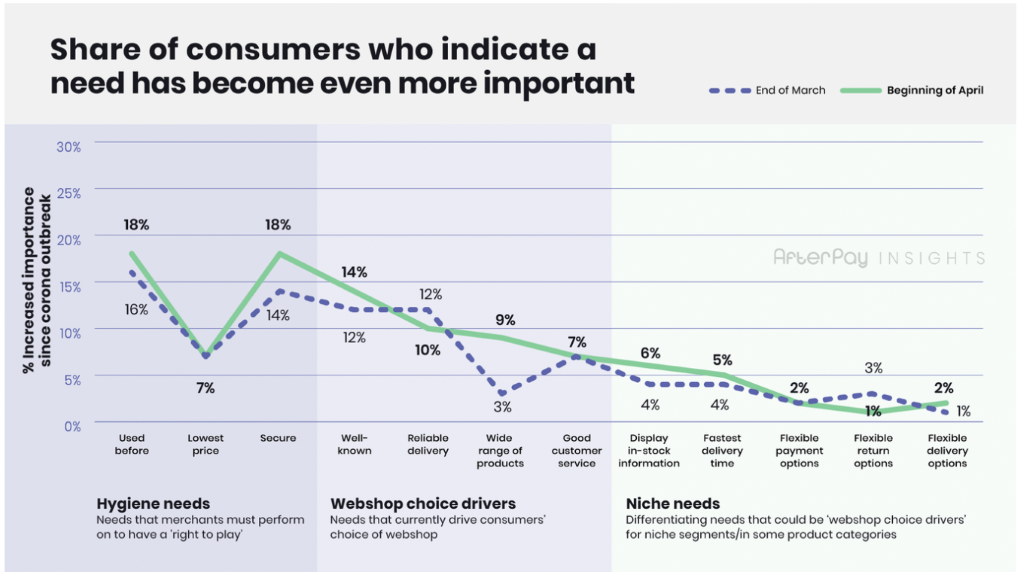Ecommerce - A decade of change in 1 year
Ecommerce - A decade of change in 1 year
Ecommerce at the start of 2020 is nothing but a tidal wave of rapid change and many companies are challenged in keeping up.
Whether it’s customization, enhanced return policies, or improved integration, all of these changes (among countless others) have taken the world of ecommerce by storm. If you don’t have an online offering at this time there is a big chance you have missed the boat, luckily Ecommerce players are jumping in with lifelines that can be deployed within a matter of days.
Posts on Linkedin are overflowing with Ecommerce connected services that have a hard time keeping up with the massive increase in business, it’s all hands onboard for distribution centers, payment suppliers, carriers and the whole IT & Ecommerce industry.
This of course is much better than being on the other side of industries that have seen their revenue evaporate in a matter of weeks, luckily several are starting to see an upturn ahead.
Ecommerce in many sectors has seen a humongous boost of 40-70% in just a matter of weeks, as we have everything shipped to us these days.
This of course is much better than being on the other side of industries that have seen their revenue evaporate in a matter of weeks, luckily several are starting to see an upturn ahead.
Ecommerce in many sectors has seen a humongous boost of 40-70% in just a matter of weeks, as we have everything shipped to us these days.
I haven’t seen the inside of a grocery store for months, everything is available with a click of a button, and I’m in the Netherlands where Amazon landed only this year!
ECOMMERCE GROWTH
It’s no surprise that Ecommerce continues to grow, Statista shows that the average growth is continuing at an average rate of 15% Year-Over-Year. And a study done by Markets & Markets shares that the investments into Ecommerce solutions is in line with this at approximately 11% YoY. If you are in the position to go digital, you might not want to wait too long and miss out.

Other trends that are fueling the growth pre-corona and probably will continue strongly during and after is that Manufacturers are going directly to Consumer (D2C), but the same can be said for B2B. Combined with the latest Salesforce State of the Connected Customer report (highly recommended to anyone in Marketing) it shows that with each generation we get more familiar/experienced with ecommerce and have grown accustomed to have everything when we want it and how we want it.
What makes the winning difference?
There are a lot of statements on what makes the difference and probably even more opinions. The market consensus seems to be that ‘Experience’ is the big differentiator.
Managing and influencing this experience is no easy task, there are plenty of influencing elements that can make or break the experience.
Common drivers:
- Was the shop used before
- Well known brand
- Seamless experience
- Price
- Security (safe shopping experience)
- Reliable Delivery
- Choice in products
- Customer Service
Each step and touchpoint contribute to the overall experience and should not be underestimated.
In a post by Afterpay (European payment solution) it shows that during the increased use of ecommerce the customers have higher expectations – and soon after an increase in negative experiences on many of these elements.

The top 3 in negative experiences are:
1. Reliable Delivery: Where the shop shows that something is on stock, to learn after ordering that there is a wait of at least 5-10 business days.2. Choice of products: Where more and more products are out of stock without knowing when they will come back in stock, to shops just reducing the amount of offered products to ensure they can actually deliver.
3. Security: Ranging from information management, stability of the vendor and secure payments.
Offering a great experience is a key element and all these parts play a role contributing to a positive experience.
How search increases the ecommerce experience
An example is shown in a webinar by Dynamicweb & Solteq that when search is being used in an ecommerce environment the chance on successful conversion goes up by 7% even when the search isn’t delivering the expected result. When the search does go well the percentage goes up to 15%, so ensure that search is well integrated in your ecommerce environment!
How PIM reduces costs and increases revenue
Another important, and often forgotten, puzzle piece is the product information management (PIM) system. Accurate rich product information including media assets will help the browser convert into buyer. Not only will it increase conversions, it will also have a positive effect on the return rate – certainly in fashion. The more accurate product information and the better the images, video’s and potentially other media files are the more the return rate will drop, reducing costs considerably (up to 50% in fashion).
Conslusion
Ecommerce is riding a massive accelerating and exhilarating wave and although it will normalize at some point, many predictions made end 2019 for coming years will need to be reviewed and significantly adjusted.
It is clear that the whole retail, manufacturing, food, commerce sector is going to be different and that it has been accelerated by maybe a decade.
A shift in focus is needed and the best moment to start is today.
